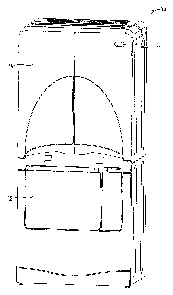Une partie des informations de ce site Web a été fournie par des sources externes. Le gouvernement du Canada n'assume aucune responsabilité concernant la précision, l'actualité ou la fiabilité des informations fournies par les sources externes. Les utilisateurs qui désirent employer cette information devraient consulter directement la source des informations. Le contenu fourni par les sources externes n'est pas assujetti aux exigences sur les langues officielles, la protection des renseignements personnels et l'accessibilité.
L'apparition de différences dans le texte et l'image des Revendications et de l'Abrégé dépend du moment auquel le document est publié. Les textes des Revendications et de l'Abrégé sont affichés :
| (12) Demande de brevet: | (11) CA 2455373 |
|---|---|
| (54) Titre français: | ARMOIRE A SECHER LE LINGE A DISTRIBUTION D'AIR AMELIOREE |
| (54) Titre anglais: | CLOTHES DRYING CABINET WITH IMPROVED AIR DISTRIBUTION |
| Statut: | Réputée abandonnée et au-delà du délai pour le rétablissement - en attente de la réponse à l’avis de communication rejetée |
| (51) Classification internationale des brevets (CIB): |
|
|---|---|
| (72) Inventeurs : |
|
| (73) Titulaires : |
|
| (71) Demandeurs : |
|
| (74) Agent: | TORYS LLP |
| (74) Co-agent: | |
| (45) Délivré: | |
| (22) Date de dépôt: | 2004-01-19 |
| (41) Mise à la disponibilité du public: | 2004-08-06 |
| Requête d'examen: | 2004-04-29 |
| Licence disponible: | S.O. |
| Cédé au domaine public: | S.O. |
| (25) Langue des documents déposés: | Anglais |
| Traité de coopération en matière de brevets (PCT): | Non |
|---|
| (30) Données de priorité de la demande: | ||||||
|---|---|---|---|---|---|---|
|
A clothes drying cabinet is provided with an internal compartment for
receiving
clothes and having a plurality of air inlet nozzles. An air plenum provides
air to the cabinet
through the nozzles. The plenum has a decreasing cross section from one corner
to an
opposite corner to provide a balanced distribution of air through the nozzles
at a
substantially uniform velocity. The nozzles are angularly oriented to direct
air across upper
and lower surfaces of shelves mounted within the drying compartment.
Note : Les revendications sont présentées dans la langue officielle dans laquelle elles ont été soumises.
Note : Les descriptions sont présentées dans la langue officielle dans laquelle elles ont été soumises.

2024-08-01 : Dans le cadre de la transition vers les Brevets de nouvelle génération (BNG), la base de données sur les brevets canadiens (BDBC) contient désormais un Historique d'événement plus détaillé, qui reproduit le Journal des événements de notre nouvelle solution interne.
Veuillez noter que les événements débutant par « Inactive : » se réfèrent à des événements qui ne sont plus utilisés dans notre nouvelle solution interne.
Pour une meilleure compréhension de l'état de la demande ou brevet qui figure sur cette page, la rubrique Mise en garde , et les descriptions de Brevet , Historique d'événement , Taxes périodiques et Historique des paiements devraient être consultées.
| Description | Date |
|---|---|
| Exigences relatives à la nomination d'un agent - jugée conforme | 2022-02-03 |
| Exigences relatives à la révocation de la nomination d'un agent - jugée conforme | 2022-02-03 |
| Demande non rétablie avant l'échéance | 2008-01-21 |
| Le délai pour l'annulation est expiré | 2008-01-21 |
| Réputée abandonnée - omission de répondre à un avis sur les taxes pour le maintien en état | 2007-01-19 |
| Modification reçue - modification volontaire | 2006-09-18 |
| Inactive : Dem. de l'examinateur par.30(2) Règles | 2006-03-23 |
| Inactive : CIB de MCD | 2006-03-12 |
| Inactive : Demande ad hoc documentée | 2004-09-14 |
| Modification reçue - modification volontaire | 2004-08-12 |
| Modification reçue - modification volontaire | 2004-08-12 |
| Demande publiée (accessible au public) | 2004-08-06 |
| Inactive : Page couverture publiée | 2004-08-05 |
| Lettre envoyée | 2004-05-21 |
| Toutes les exigences pour l'examen - jugée conforme | 2004-04-29 |
| Exigences pour une requête d'examen - jugée conforme | 2004-04-29 |
| Requête d'examen reçue | 2004-04-29 |
| Inactive : CIB attribuée | 2004-04-28 |
| Inactive : CIB en 1re position | 2004-04-28 |
| Inactive : Certificat de dépôt - Sans RE (Anglais) | 2004-02-26 |
| Lettre envoyée | 2004-02-26 |
| Demande reçue - nationale ordinaire | 2004-02-26 |
| Date d'abandonnement | Raison | Date de rétablissement |
|---|---|---|
| 2007-01-19 |
Le dernier paiement a été reçu le 2005-12-13
Avis : Si le paiement en totalité n'a pas été reçu au plus tard à la date indiquée, une taxe supplémentaire peut être imposée, soit une des taxes suivantes :
Les taxes sur les brevets sont ajustées au 1er janvier de chaque année. Les montants ci-dessus sont les montants actuels s'ils sont reçus au plus tard le 31 décembre de l'année en cours.
Veuillez vous référer à la page web des
taxes sur les brevets
de l'OPIC pour voir tous les montants actuels des taxes.
| Type de taxes | Anniversaire | Échéance | Date payée |
|---|---|---|---|
| Enregistrement d'un document | 2004-01-19 | ||
| Taxe pour le dépôt - générale | 2004-01-19 | ||
| Requête d'examen - générale | 2004-04-29 | ||
| TM (demande, 2e anniv.) - générale | 02 | 2006-01-19 | 2005-12-13 |
Les titulaires actuels et antérieures au dossier sont affichés en ordre alphabétique.
| Titulaires actuels au dossier |
|---|
| MAYTAG CORPORATION |
| Titulaires antérieures au dossier |
|---|
| DENNIS S. PROWS |